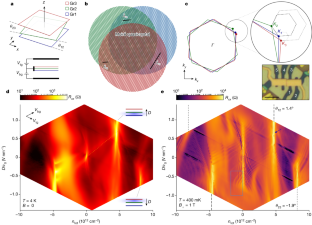Phys.org September 28, 2023
Owing to their complexity and scarcity, quasicrystals are underexplored relative to periodic and amorphous structures. An international team of researchers (USA – MIT, Japan, Israel) introduced a new type of highly tunable quasicrystal easily assembled from periodic components. By twisting three layers of graphene with two different twist angles, they formed two mutually incommensurate moiré patterns. In contrast to many common atomic-scale quasicrystals, the quasiperiodicity in their system was defined on moiré length scales of several nanometres. This ‘moiré quasicrystal’ allowed them to tune the chemical potential and thus the electronic system between a periodic-like regime at low energies and a strongly quasiperiodic regime at higher energies, the latter hosting a large density of weakly dispersing states. In the quasiperiodic regime, they observed superconductivity near a flavour-symmetry-breaking phase transition, the latter indicative of the important role that electronic interactions play in that regime. According to the researchers the prevalence of interacting phenomena in future systems with in-situ tunability is not only useful for the study of quasiperiodic systems but may also provide insights into electronic ordering in related periodic moiré crystals. They anticipate that extending this platform to engineer quasicrystals by varying the number of layers and twist angles, and by using different two-dimensional components, will lead to a new family of quantum materials to investigate the properties of strongly interacting quasicrystals… read more. TECHNICAL ARTICLE

Realization of a moiré quasicrystal in two-angle TTG. Credit: Nature volume 620, pages762–767 (2023)